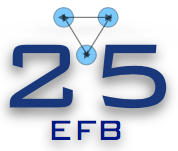Speaker
Description
Despite a century after the discovery of neutrons by E. Rutherford, few details are known for sure about this particle. For example, neutron halos, prototypical examples of the quantum realm, were discovered a few decades ago from indirect measurements. In an ambitious attempt, the PUMA experiment at CERN [1] will use the antiproton's unique property, i.e., the annihilation process's sensitivity to the nuclear density's tail, to study the neutron/proton distribution asymmetry at the surface of the nuclei. To support the experimental endeavor, we aim to provide theoretical guidance to answer the key questions of the experiment. To study the antiproton's annihilation as a probe for the nuclear surface, we rely on the high-fidelity ab initio reaction method and Effective Field Theory (EFT). To begin with, we will introduce various nucleon-antinucleon ($N\bar{N}$) interactions in our nuclear reaction tools and develop the ability to compute low-energy antiprotonic atomic states, the so-called quasi-bound states, and reaction cross-sections of light-nuclei antiprotonic systems. In other words, we introduce $N\bar{N}$ optical potentials into the No-Core Shell Model combined with the Resonating Group Method (NCSM/RGM) [2] to study the sensitivity of the many-nucleon observable to $N\bar{N}$ optical potential models and EFT-derived potentials. This exploration will give important information on the properties of the $N\bar{N}$ system below the threshold and determine the current theoretical uncertainties. Furthermore, we aim to compute annihilation properties of antiprotonic systems made from Helium to Oxygen stable isotopes with the high-precision EFTs for the nuclear sector before the advent of experimental data. The overarching goal is a unified description of nuclei and antiprotonic atoms within the theory used in both sectors.
References
[1] T. Aumann, W. Bartmann, O. Boine-Frankenheim, A. Bouvard, A. Broche, F. Butin, D. Calvet, J. Carbonell, P. Chiggiato, H. De Gersem, R. De Oliveira, T. Dobers, F. Ehm, J. F. Somoza, J. Fischer, M. Fraser, E. Friedrich, A. Frotscher, M. Gomez-Ramos, J.-L. Grenard, A. Hobl, G. Hupin, A. Husson, P. Indelicato, K. Johnston, C. Klink, Y. Kubota, R. Lazauskas, S. Malbrunot-Ettenauer, N. Marsic, W. F. O M ̈uller, S. Naimi, N. Nakatsuka, R. Necca, D. Neidherr, G. Neyens, A. Obertelli, Y. Ono, S. Pasinelli, N. Paul, E. C. Pollacco, D. Rossi, H. Scheit, M. Schlaich, A. Schmidt, L. Schweikhard, R. Seki, S. Sels, E. Siesling, T. Uesaka, M. Viĺen, M. Wada, F. Wienholtz, S. Wycech, and S. Zacarias, European Physical Journal A 58, 88 (2022).
[2] P. Navrátil, S. Quaglioni, G. Hupin, C. Romero-Redondo, and A. Calci, Physica Scripta 91, 053002 (2016).

